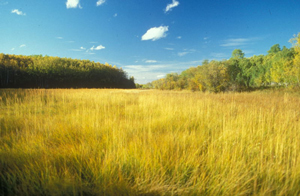
Vegetation
Wood Buffalo National Park
There are nine common plant communities found in the Peace-Athabasca Delta, each adapted to its own characteristic water regime. They include aquatic vegetation, emergent vegetation, sedges, wet grasses, and dry grasses as well as meadows, willow thickets and forests.
With water as the main driver of vegetation patterns, plant species generally fall along a gradient from open water (aquatic species) to shoreline (emergent species), wet meadow, dry meadow, and on through to upland conditions.
Flooding, fire, and grazing by herbivores are the three main factors influencing the type and abundance of vegetation cover in the delta.
Significance of Flooding

The most productive areas of the delta are those areas that are frequently flooded. Periodic flooding maintains early successional forms of vegetation (such as aquatic species, emergent species, sedges and wet grasses) within the wetlands and perched basins. This in turn creates favourable habitat for a rich diversity of wildlife such as muskrats, waterfowl, moose, and bison.
Muskrats, for example, survive best in relatively shallow marshes with an abundance of aquatic and emergent vegetation. The delta’s shorelines and perched basins provide an important summer refuge for ducks from all four North American flyways. This is especially critical during years of prairie drought. Bison frequent the delta to graze on the sedges and grasses that are common to these flooded marsh environments. Many other animals, such as beavers, weasels, otters, mink, fox, moose, and bears, are also attracted to these productive habitats.
Significance of Fire
Fire has a strong influence on vegetation in the delta. Historically, the fire regime has been both natural (lightning-caused) and with human influence. Traditional Indigenous spring burning used to occur to encourage fresh new growth of grasses and shrubs. This in turn helped to attract desired game species such as moose and bison. Twentieth century fire suppression policies interrupted this regime. Today, fires in the delta are monitored and allowed to burn except when values-at-risk are threatened in which case appropriate fire management actions are taken.

Significance of Grazing
Herbivores (plant eaters) thrive within the productive habitats of the delta. These include aquatic animals such as fish, semi-aquatic animals such as beavers and muskrats, and terrestrial animals such as hare, moose, and bison. Their grazing activities play an important role in maintaining the vegetative diversity of the delta. For example, grazing of meadow grasses by bison helps keep shrubs such as willows from moving in.
Invasive species

Non-native plant species have been documented in the delta for decades. They are most likely to become established in areas which experience frequent disturbances – whether from flooding, fire, wallowing by bison, or drying of perched basins. The intense management of bison at Sweetgrass Station in Wood Buffalo National Park (1950 – 1970) may have introduced some prominent weed species such as Canada thistle and sow thistle. Roadways, rivers, and wind are also conduits for non-native seeds from other parts of the province.
Monitoring in Wood Buffalo National Park indicates that the extent of invasive species is greatest in some of the delta meadows within the Peace River sector of the delta and has been increasing in these areas over time. In contrast, the abundance of invasive species in the Athabasca River sector of the delta, which is more active in terms of sediment deposition and experiences more frequent flooding from high water events, has remained relatively stable.
- Date modified :